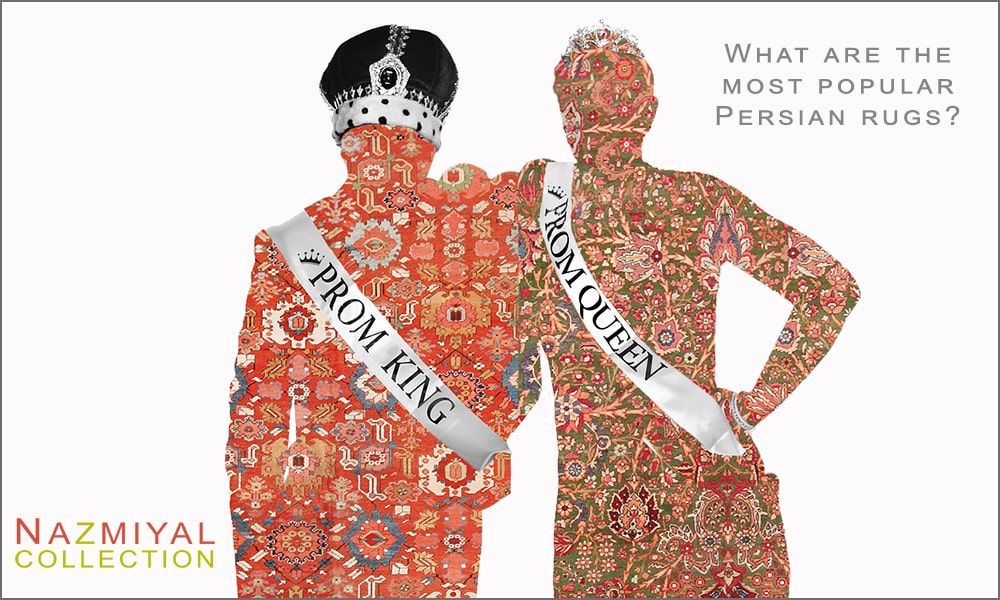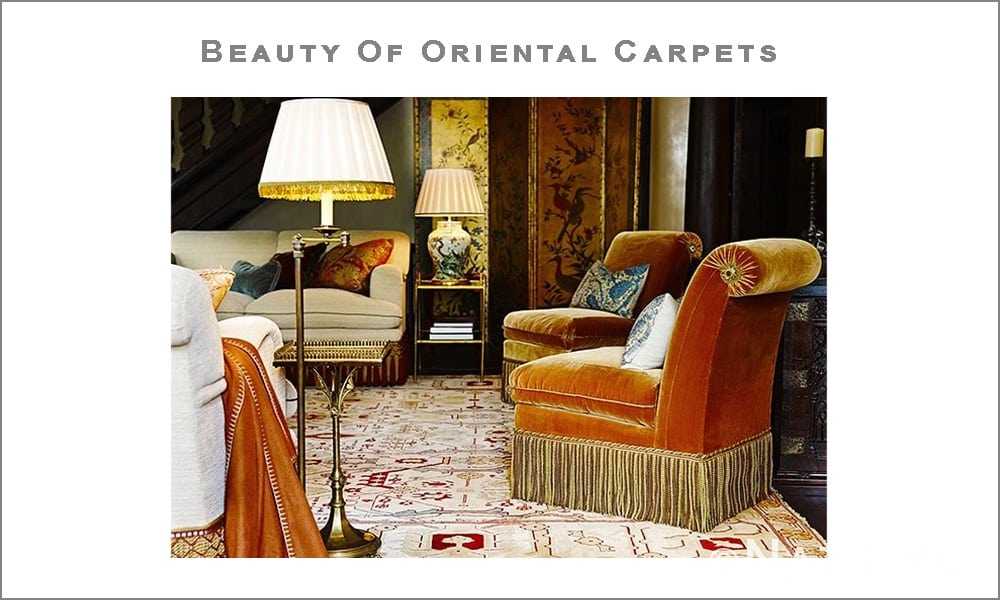Taking A Deeper Look At What Oriental Rugs Are And What They Are Not
Shop Traditional Oriental Rugs | Shop Persian Rugs | Shop Turkish Rugs | Shop Chinese Rugs | Shop Indian Rugs | Shop Caucasian Rugs
Shop All Antique Rugs | Shop All Vintage Rugs | Shop All Modern Rugs | Make Your Own Custom Area Rug
What is considered an Oriental rug?
By simple definition, any area rug that was produced in anywhere throughout the Asian continent (the “Orient”) would be, by definition, classified as an “Oriental rug”.
Are Oriental rugs and Persian rugs the same?
Not exactly. All Persian rugs are Oriental but not all Oriental rugs are Persian.

Oriental Rugs Explained
What is the difference between an Oriental rug and a Persian rug?
The simplest way to explain the difference between Oriental and Persian Rugs is as follows:
Since all Persian rugs were woven in Asia they are all also considered Oriental rugs. But since not all Oriental rugs were woven in Persia, not all Oriental rugs would be Persian rugs.
What are some examples of area rugs that are Oriental but not Persian?
Aside from Persian rugs, other types of Oriental rugs are usually grouped into several other categories based on the country and place of origin of the rug.
Some examples of area rug types that are Oriental but not Persian would be: Chinese rugs, Indian rugs, Tibetan rugs, Kurdish rugs, Caucasian rugs, Turkish rugs, Central Asian rugs and other area rugs from Asian counties as well.
What are the most popular types and styles of Oriental rugs?
There are literally hundreds of different Oriental rug types and styles, each with their own characteristic. The world of rugs is much larger than most assume. If you consider that people have been weaving rugs as far back as the ancient Egyptians, then you can start to comprehend how diverse the styles have evolved over the last three thousand or so years. Also, note that evidence of ancient rug weaving has been found on every major continent.
As previously noted, the styles of Oriental rugs are incredibly diverse, reflecting the rich artistic heritage and cultural influences of the regions where they are produced. These rugs have been woven for centuries in various countries across the Middle East, Central Asia, South Asia, and East Asia. Each region has its unique weaving techniques, designs, motifs, and color palettes, resulting in a vast array of styles.
While Oriental rugs are so varied and each location has its own special nuances, when we step back and look at the Oriental rug production over time and as a whole, a few types / origins have a more established record.
The 5 most recognizable styles and popular types of Oriental rugs are:
- Rugs from Persia – Originating from Iran (historically known as Persia), Persian rugs are among the most famous and highly regarded Oriental rugs. They are known for their intricate designs, detailed floral motifs, and use of natural materials such as wool, silk, and cotton.
- Rugs from Turkey – Originating from Turkey, Turkish rugs often feature bold geometric patterns, medallions, and vibrant color combinations. They are usually made using high-quality wool and are known for their durability.
- Rugs from China – The Chinese rugs are characterized by their elegant designs, often featuring dragons, floral motifs, and intricate borders. They are usually made from silk and have a distinct Chinese artistic influence.
- Rugs from India – India has a long history of rug weaving, and Indian rugs often feature a blend of Persian and local designs. They can vary from traditional floral patterns to more contemporary and abstract motifs.
- Rugs from the Caucasus – The Caucasus region, which includes countries like Azerbaijan and Armenia, Caucasian rugs display a wide range of designs, including geometric patterns, animal motifs, and vibrant colors.
The above 5 rug weaving origins are probably the most iconic, but keep in mind that other regions wove some magnificent area rugs as well. Each Oriental rug style has its own unique characteristics and cultural significance, making Oriental rugs a fascinating, historically significant and valuable art form that is appreciated by collectors and connoisseurs worldwide.
The famous Persian Oriental area rug
Some of the most well known types of area rugs that would be considered “Oriental” are the iconic area rugs that were woven in Persia – the modern day country of Iran. These are some of the oldest and finest quality rugs in the world. The tradition of Persian rug weaving has been passed down through the generations, so that fine handmade carpets are still being produced in modern times. The art of rug making, however, dates back to about 500 B.C. This is when the oldest surviving rug dates from. It is called the Pazyryk carpet, and demonstrates the same way that Persians use colors and decorative geometrical patterns in their rug making.
Each area has a specific way it designs its rugs, and a specific weaving or knotting technique. In addition, colors and patterns vary from region to region, depending on what is considered to be traditional. There are also many similarities between rugs of different regions, however, as they all share a common art.
What does the word “Oriental” actually mean?
The term “Oriental” historically referred to the East or the Eastern world, specifically the regions of Asia, including the Middle East, South Asia, East Asia, and Southeast Asia. It has its roots in Latin and was first used in English during the 14th century to describe the regions to the east of Europe. The word “Oriental” is derived from the Latin word “Orientalis,” which means “eastern.”
For a long time, the term was used in a neutral manner to refer to cultures, people, or objects from these Eastern regions. However, over time, the word has acquired some problematic connotations, particularly in Western contexts, as it can be seen as Eurocentric and potentially perpetuating stereotypes or exoticizing the cultures it refers to.
Because of these connotations, the usage of “Oriental” has become less common in contemporary discourse, and many people now prefer more specific and culturally sensitive terms when referring to people, places, or objects from these regions.
For instance, it’s more appropriate to use terms like “Asian” or refer to the specific country or culture in question, rather than using the blanket term “Oriental.”
Aside from origin, what makes an Oriental rug Oriental?
In addition to the place of origin, the term “Oriental” in the rug world, can also refer to the specific types of approach to the rug patterns as well. These beautiful “Oriental” patterns vary tremendously and can be floral, geometric, refined and intricate, or open and large scale.
Though the designs of Oriental rugs diverge depending on the specific region of Asia from where they originated, as a group, the carpets from the Orient represent over two thousand years of artistic evolution and can contain motifs that date as far back as 500 BC.
How old do Oriental rugs need to be for them to be considered antique or vintage?
By definition, “antique Oriental rugs” need to be at least 80 years old, while “vintage oriental rugs” refers to the decorative Oriental and more modernist area rugs that were made and designed during the mid 20th century – such as the mid-century modern area rugs.
Did the approach to Oriental rug production change overtime?
On the surface, new modern area rugs and carpets may resemble their older more mature “antique Oriental cousins”, but the similarities and differences do not stop there.
The quality and construction of Oriental carpets are two of the great differences between those created then and now. These differences affect the overall look and feel on a broad level through small and large changes in the dyeing, spinning, and weaving process. The difference between new and antique Oriental carpets goes down to the fiber used to produce these masterpieces from the past. Using millennial-old processes, world created iconic antique rugs that would stand the test of time and add to their international legacy.

Silk Khotan Oriental Rug
What are main differences between the old Oriental rugs and new Oriental rugs?
Oriental rugs, have a rich history dating back thousands of years. Over time, various factors have influenced the differences between the antique or old Oriental rugs and the modern ones made today.
Here are some key distinctions that set the new Oriental rugs apart from the antique:
- Age and Rarity: Antique Oriental rugs were handwoven several decades or even centuries ago, making them valuable artifacts with a unique historical significance. The rare rugs often carry a sense of mystery and craftsmanship from bygone eras. In contrast, modern Oriental rugs are produced in larger quantities using both traditional and modern techniques, making them more readily available.
- Materials: Old Oriental rugs were typically made from natural fibers such as wool, silk, and cotton. Wool was the most common material due to its durability and abundance in the regions where these types of area rugs originated. In contrast, while some modern Oriental rugs may still use traditional materials, many tend to also incorporate synthetic fibers or blends to cater to different price points and consumer preferences.
- Design and Patterns: Antique Oriental rugs often showcase captivating designs and patterns, each reflecting the unique artistic expression of the region and the weaver. The rug patterns and motifs were passed down through generations, and each rug tells a story of the culture and heritage it represents. Modern Oriental rugs, while still inspired by traditional patterns, may also incorporate contemporary designs and colors to appeal to a wider audience and fit diverse interior aesthetics.
- Handmade vs. Machine-made: Antique Oriental rugs were entirely handcrafted, reflecting the expertise and artistic skills of the weavers. Each of the rugs produced were a labor of love and could take months or even years to complete. In contrast, modern Oriental rugs are often produced using machines, which allows for faster production and lower costs. That said, not all of these area rugs are machine made with some modern rugs being made by hand, preserving the traditional craftsmanship.
- Value and Investment: Antique Oriental rugs are highly valued in the market due to their historical significance, rarity, and the artistry involved in their creation. The more rare and best examples of the rugs often appreciate in value over time and such rugs can be considered valuable investments. Modern Oriental rugs, especially those made by machines, tend to be cheaper rugs and more affordable types of rugs and are not typically seen as high-value investments like their antique counterparts.
- Dyeing Techniques: In the past, natural rug dyes extracted from plants, insects, and minerals were commonly used to color Oriental rugs. These dyes created rich, muted tones that are highly sought after today. Modern Oriental rugs may use both natural and synthetic dyes, offering a wider range of vibrant rug colors and hues.
While some of the better modern Oriental rugs still carry the essence of their ancient heritage, the differences mentioned above are reflective of the evolution of rug-making techniques, materials used to make the rugs, and designs over time. Both antique and modern Oriental rugs hold their own appeal, catering to different tastes, preferences, and budgets of consumers.
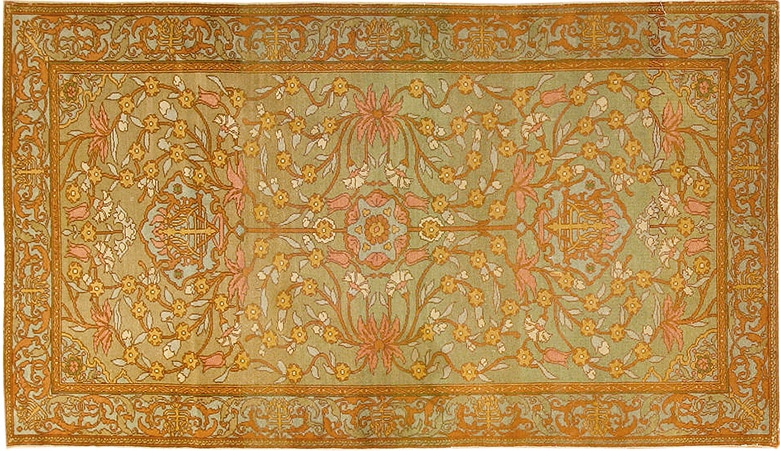
Antique Bezalel Oriental Rug
Do the Symbols in Traditional Oriental Rugs Have Meaning?
To the weaver, many of the symbols do have meaning. Especially to a semi-nomadic tribal group, universal and region-specific symbols such as water, animals, birds, people and amulets were vital to protect their family and resources. Often created for specific purposes, traditional Oriental rugs and carpets from Persia, Turkey, India, the Caucasus, China, Tibet and so many other regions were produced by craftspeople who put their heart and soul into every step of the process.
Over the centuries, the weaving of an Oriental rug has evolved from a cultural craft into a livelihood and an art form that captures many diverse traditions. The craftspeople and master weavers who created these antiquities used exacting precision to execute intricate patterns and rug symbols that today’s high-technology advances are unable to replicate.
How are Oriental rugs woven?
Weaving Oriental rugs is a complex and intricate process that requires skilled craftsmanship and attention to detail. While the exact steps may vary depending on the region and style of the rug, we will focus on the stages involved in weaving Oriental rugs.
Here are the different steps of weaving Oriental rugs:
- Design and Planning: The process begins with the creation of the rug’s design. Master weavers or designers draw the pattern on paper or sometimes directly on a special graph paper known as “cartoon.” The design includes the colors, motifs, and dimensions of the rug.
- Selection of Materials: The best high-quality area rug weaving materials are essential for creating durable and beautiful Oriental rugs. Traditional rugs are typically made from natural fibers like wool, silk, and cotton. The selection of materials depends on the style and budget of the rug.
- Carding and Spinning: The wool fibers are cleaned and carded to remove impurities and align the fibers. This process ensures a smooth and even texture. The carded wool is then spun into yarns, which will be used for the rug’s foundation and pile.
- Dyeing: Before weaving, the yarns are dyed using natural or synthetic dyes. In traditional rug-making, natural dyes extracted from plants, insects, and minerals were commonly used, but synthetic dyes are also widely used today for their wide range of colors and consistency.
- Setting up the Loom:The loom is the frame used for weaving the rug. The warp threads, which run vertically on the loom, are stretched and secured to create the foundation of the rug. The weft threads, which run horizontally, are then woven through the warp to create the base structure.
- Knotting or Weaving: The actual weaving process begins by knotting or weaving the yarns around the warp threads.The type of rug knots used depends on the style of the rug. The two most common knots are the Turkish (Ghiordes) knot and the Persian (Senneh) knot.
- Pile and Pattern Formation: As the weaver progresses row by row, the design and patterns of the rug start to take shape. The pile height is determined by the number of knots tied in each row.
- Trimming and Shearing: Once a section of the rug is completed, it is trimmed and sheared to achieve a uniform surface and even pile height. This process of shearing the area rugs gives them a smooth and polished appearance.
- Washing and Finishing: The completed rug is thoroughly cleaned and washed to remove any excess dye and dirt. Washing also enhances the rug’s colors and softens the fibers. After washing, the rug is left to dry naturally. Finally, any additional finishing touches, such as making sure the different parts of the rug are all set such as the fringes or binding, are added.
- Inspection and Quality Control: The rug is carefully inspected to ensure the design, colors, and weaving quality meet the desired standards. Any necessary corrections or adjustments are made at this stage.
- Marketing and Distribution: Once the rug is deemed complete and of satisfactory quality, it is prepared for marketing and distribution, either through local markets, rug dealers / stores and galleries, or international sales.
Each step of the weaving process requires skill, patience, and attention to detail. Depending on the size and complexity of the rug, the weaving process can take several months to even years to complete, resulting in a truly remarkable work of art with a rich cultural heritage.
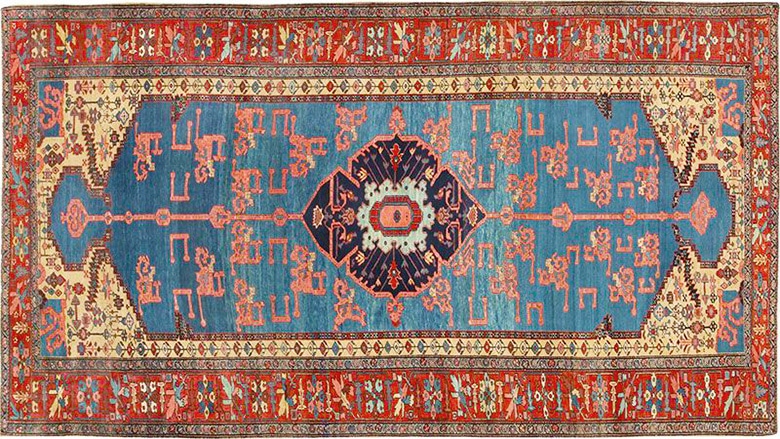
Antique Bakshaish Persian Oriental Rug
Are antique Oriental rugs more expensive than newly made ones?
Although antique Oriental rugs make excellent investments, when shopping for rugs, the older ones , may often be acquired without a significant increase in cost compared to the newly manufactured rugs in today’s markets. There is no question that rugs make outstanding decorative objects as well as investment pieces for serious collectors and / or buyers who wish to beautify, soften, or complete an interior space while making a sound financial decision.
What is the History of Oriental Rugs?
The original traditional antique Oriental rugs have always been synonymous with exotic luxury, elegant design and a comfortable, highly aesthetic environment. From the earliest times, humans have needed to embellish and ornament the circumstances in which they lived, and the medium of woven carpets soon emerged to meet such requirements. Carpet production is attested from ancient times. Flat-woven floor coverings are probably as old as textiles and architecture.
The oldest knotted pile carpets can be attested by the sixth century B.C., but their production may well be considerably older. Some experts believe that pile carpets originated among tent-dwelling nomadic peoples to the east of Central Asia as a more decorative substitute for animal hides, providing comfort and insulation as well as decoration.
Carpet making reached the Near East through contact with such nomadic peoples. Since relations between Central Asian nomads and the Near East were more or less constant, the production of pile carpets in the latter region was probably stimulated and influenced by nomadic traditions again and again.
This process first becomes clear in the medieval period, between the eleventh and the fourteenth centuries, when various Central and East Asian peoples like the Turks and Mongols came to power across the eastern Islamic world, bringing with them traditions of carpet making that were by now many centuries old.
The earliest Near Eastern carpets of this kind are those of Seljuk Turkey and those made in Iran under the Mongol and Timurid dynasties. The traditional carpets of this kind now began to have highly complex designs influenced by contemporary textiles, especially silks.
From this period on, the knotted pile Islamic carpet became an increasingly standard feature of Islamic art and high culture, and soon it captured the attention of wealthy Europeans as well. Already by the thirteenth century, merchant travelers like Marco Polo remarked on the beauty of the Oriental carpets they encountered on their journeys, and soon such carpets began to be imported into Venice and thence to the rest of Europe.

A Guide To Antique Oriental Rugs
While actual early traditional rugs of this kind are rarely preserved, European painting by the great masters from Giotto and Ghirlandaio to Holbein, van Eyck, Lotto, and Vermeer constantly depict carpets from Turkey and Iran. Such paintings document the importance that the Oriental rug had attained by this time as a quintessential symbol of cosmopolitan taste and affluence. So valued were these carpets that there were various attempts to imitate or adapt them in Europe.
After the 17th century, Europeans briefly lost interest in the Oriental carpet. This probably reflected developments in the Near and Middle East, where all the great ruling dynasties collapsed or went into regression, bringing about a corresponding roll-back in the quantity and quality of carpet production.
During this hiatus, European carpet production was stepped up, creating the Aubusson and Savonnerie types in a Neo-Classical western style. Carpet production in Spain, which had begun under Muslim rule in the Middle Ages, also moved in to meet the European demand for rugs.
In the second half of the nineteenth century, rug weaving in Iran went into a great period of revival under the highly retrospective Qajar dynasty, re-awakening the European interest for these rugs and creating a new American market for them as well. This eventually led to a revival or expansion of carpet production in Turkey and also a revival of Indian carpet weaving under British rule. At this time Chinese rugs, whose production went back to ancient times, finally became known in quantity to European and American markets.
From that time on the western world became used to an endless variety of rugs and carpets whose production continues into the present time. The most notable recent developments are the revival of vegetable dyes and hand-spinning of wool, which had largely died away in the course of the twentieth century.
Such new productions capture much of the quality and original flavor of antique Oriental rugs. But only a genuine antique can preserve the soul and spirit of the weaving. These pieces are an art form that reaches back, virtually unbroken, to the earliest times. Antique carpets from the Orient are not only objects of great beauty and rarity, they are a much-needed bridge to a bygone world of consummate skill and expressiveness that is vastly different from the mass-culture of modern western experience.
Today, we think of decorative rugs primarily as a floor covering. Occasionally, they are used as a wall decoration. But, thousands of years ago, when the art of rug weaving was being perfected, dozens of practical uses were attributed to rugs and carpets.
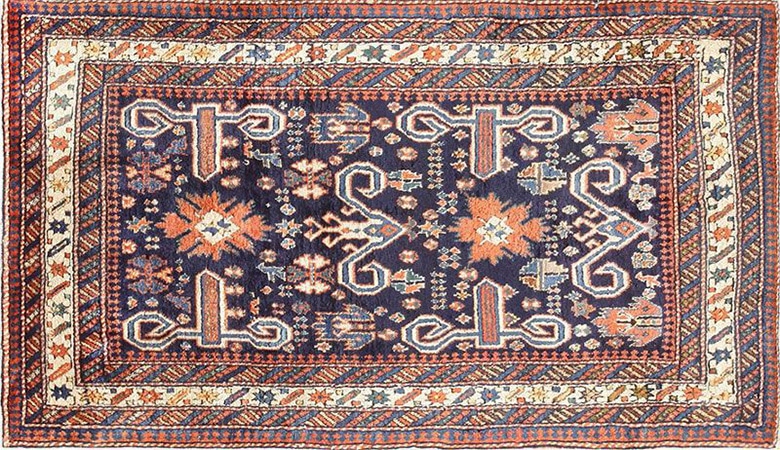
Antique Caucasian Perpedil Shirvan Oriental Rug
What are some of the different uses of Oriental rugs?
Other than decorative and utilitarian objects to enhance you home decor, Oriental rugs also served other purposes.
Here are a few examples of different uses of Oriental rugs:
- Prayer: The first and arguably most famous use of Oriental rugs was as Islamic prayer rugs. A small three foot by five foot rug could be transported wherever the owner traveled. Many of the people inhabiting the ancient Middle-East were nomadic and many are Muslim so having the ability to carry around their prayer design rugs was very important.
- Saddle bags: Traveling constantly brought about a few other uses. One example would be the saddle rugs. Saddle rugs, for horses and camels were primarily used for padding the back of the animal so a saddle can be placed on top. But “bags” were also created to mount on the beast of burden for storage and safe keeping while traveling.
- Protection: For long nomadic trips through the desert, a rug can also be placed on top of the saddle or around the torso of the rider. Thick rugs provide good protection from sandstorms and extreme temperatures – especially during the cold desert nights.
- Wall Hangings: Some Oriental rugs are considered works of art, and they are often displayed as decorative wall hanging tapestries. They can add a touch of cultural heritage and elegance to a room’s decor.
- Table Covers: Smaller Oriental rugs can be used as table covers, adding a touch of color and pattern to dining tables, coffee tables, or side tables.
- Furniture Covers: Oriental rugs can be used to cover furniture pieces like sofas or chairs, providing both protection and a unique aesthetic.
- Bed Throws: Some smaller Oriental rugs can be used as decorative bed throws or runners at the foot of the bed, enhancing the bedroom’s overall look.
- Meditation and Yoga Spaces: In some settings, Oriental rugs are used to create serene and comfortable meditation or yoga spaces due to their softness and cultural symbolism.
- Collector’s Items: Antique and rare Oriental rugs are often collected by enthusiasts and can be displayed in showcases or special exhibition spaces.
- Event Decor: Oriental rugs can be rented or used as event decor for weddings, parties, and other special occasions, especially in settings with a cultural or vintage theme.
- Gifts: Oriental rugs are sometimes given as special gifts for weddings, anniversaries, or housewarmings, symbolizing warmth, beauty, and cultural appreciation.
These are just a few examples of how Oriental rugs were used beyond their decorative floor covering nature. Of course rugs were used in other ways as well. Overall, the uses of Oriental rugs have evolved over time, adapting to different cultural, artistic, and practical needs, while still maintaining their status as valuable and cherished items in many households and settings worldwide.
How were Oriental rugs used for communication?
Traditional Oriental rugs were used as a means of communication through the use of symbols and motifs woven into the rug’s design. These symbols and motifs held specific meanings and conveyed messages to those who were familiar with their cultural significance. While not all Oriental rugs were used for communication purposes, some were created with the intention of carrying symbolic messages or representing specific cultural or religious beliefs.
Here’s how some Oriental rugs were used for communication:
- Tribal and Cultural Identity: Different Oriental rugs were associated with specific tribes or ethnic groups, and their designs often reflected the cultural identity of the weavers. These rugs could act as a form of identification, indicating the origin of the weaver or the region to which the rug belonged.
- Storytelling and Mythology: Some Oriental rugs featured intricate designs and motifs that told stories from mythology or historical events. These rugs acted as a visual representation of tales and legends, preserving cultural narratives and passing them down through generations.
- Religious Symbolism: In certain Oriental rug designs, religious and biblical symbols and motifs were incorporated, reflecting the spiritual beliefs and values of the weavers and the community. These rugs could be used in religious spaces or for religious ceremonies.
- Protective and Superstitious Beliefs: It was believed that some Oriental rugs had protective qualities, warding off evil spirits or bringing good luck to the household. Symbols such as

Using Oriental rugs For Communication
the “evil eye,” talismans, or other protective motifs were woven into the rugs to serve these purposes.
- Status and Wealth: In some cultures, the design and quality of an Oriental rug were indicative of the owner’s social status and wealth. Elaborate and intricately designed rugs were often reserved for the wealthy and noble families.
- Marriage and Wedding Gifts: Oriental rugs were sometimes given as wedding gifts, and the design of the rug could carry specific blessings for the newlyweds or symbolize fertility, prosperity, and happiness.
- Diplomacy and Gift-Giving: Oriental rugs were sometimes used as diplomatic gifts between rulers and dignitaries of different regions or countries. These rugs could represent a gesture of goodwill, friendship, or alliance.
- Language of Love and Sentiments: Some Oriental rugs featured floral motifs or symbols representing love, affection, or specific sentiments. These rugs could be gifted to express feelings or used to decorate spaces during romantic occasions.
The use of Oriental rugs for communication through symbolism and motifs varied across different cultures, regions, and time periods. The meanings attached to specific symbols could also evolve or change over time, adding further complexity to the language of these rugs. Today, while the traditional use of Oriental rugs for communication may have diminished, the cultural and artistic value of these rugs continues to be appreciated and preserved.
You may also want to read: Are Oriental Rugs Out of Style in 2022? | Home Interior Decorating With Persian and Oriental Antique Rugs
This rug blog that talks about what Oriental rugs are and what they are not was published by Nazmiyal Rugs

